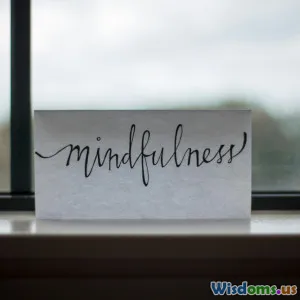
Guided Visualization vs Silent Meditation Which Leads to Awareness Faster
10 min read Explore which practice—guided visualization or silent meditation—builds awareness faster through science, practice, and expert insights. (0 Reviews)
Guided Visualization vs Silent Meditation: Which Leads to Awareness Faster?
Achieving a heightened awareness of oneself and the present moment is a universally sought goal in mindfulness practices. Yet, when confronted with the various meditation techniques available, such as guided visualization and silent meditation, many wonder: Which path leads to awareness faster? This article dives deep to unravel the nuances of both practices, exploring their approaches, benefits, and scientifically documented effects.
Introduction
“In the stillness of the mind, true awareness dawns.” This adage underscores the essence of meditation – to cultivate a receptive and conscious state of being. But the journey there varies. Guided visualization paints a vivid mental landscape steering the mind through imagery and narratives, while silent meditation invites stillness without narrative guidance. As practitioners face a choice, understanding how each influences awareness can clarify their path.
Understanding Key Concepts
What Is Guided Visualization?
Guided visualization is a meditative practice where an instructor or recording guides the practitioner through a series of imaginative scenes designed to evoke sensory experience, emotions, and inner responses. For instance, a guide may lead you through a peaceful forest, prompting you to notice the rustling leaves or the warmth of sunlight, activating multi-sensory awareness.
Historical roots trace back to Tibetan Buddhism's use of deity visualization and Eastern practices incorporating imagery for mental conditioning. Today, it is widely adopted in therapeutic contexts such as stress reduction, pain management, and enhancing creativity.
What Is Silent Meditation?
Silent meditation generally involves sitting quietly with minimal guidance, focusing on breath, bodily sensations, sounds, or open awareness without attaching to thoughts. Mindfulness meditation, transcendental meditation, and Vipassana typically fall under this umbrella.
Silent meditation emphasizes direct experiential awareness and often demands discipline to stay present amid the mind’s natural distractions, fostering deep mental clarity and insight over time.
The Mechanisms of Cultivating Awareness
How Guided Visualization Accelerates Awareness
Guided visualization leverages the power of the imagination and sensory engagement. By immersing practitioners in detailed scenarios, it channels scattered thoughts into a coherent storyline. This focused mental activity can quickly establish a relaxed, centered state—often perceived as awareness—by:
- Redirecting attention from random thoughts to intentional imagery.
- Engaging multiple senses to deepen mindfulness.
- Providing scaffolding for beginners not yet skilled in silent attentional control.
For example, a study in the International Journal of Behavioral Medicine (2018) showed participants using guided imagery reduced anxiety and enhanced emotional regulation faster than those who only practiced silent meditation initially.
How Silent Meditation Cultivates Awareness
Silent meditation strips away the narrative, presenting awareness in its raw form. Through ongoing attention to breath or sensations, practitioners start recognizing the transient nature of thoughts and emotions, cultivating metacognitive awareness — knowing that one knows. Achieving this level:
- Requires dual attentiveness: observing the stream of consciousness and redirecting focus as thoughts intervene.
- Fosters insight into the self's impermanence and thought patterns.
- Strengthens cognitive control and emotional resilience.
According to research in Frontiers in Human Neuroscience (2020), experienced silent meditators displayed increased connectivity between brain regions associated with self-referential processing and attention regulation compared to novices, highlighting the brain's adaptability with sustained silent practice.
Comparative Effectiveness: Which is Faster?
Speed of Entry into Awareness
Guided visualization often leads to a quicker induction of a relaxed, focused state. Beginners especially benefit from concrete cues and imagery that reduce mental chaos. For instance, many relaxation or stress-reduction programs start with visualization precisely because of its accessibility.
Silent meditation, conversely, may be slower to induce awareness due to the need for cognitive discipline. The unfamiliarity with sitting silently can initially spawn more wandering thoughts, delaying the arrival at awareness.
Depth of Awareness and Insight
While guided visualization accelerates entry, silent meditation tends to deepen over time, enabling refined introspection and insight beyond surface sensations. Seasoned meditators often report a subtle yet profound sense of awareness not reliant on imagery but sustained by pure presence.
Practical Considerations
- Skill Level: Novices find guided visualization more supportive; silent meditation is demanding but with persistent practice offers durable outcomes.
- Emotional Conditions: Visualization can evoke unwanted images or emotional reactions, requiring sensitive guidance.
- Objective: If immediate relaxation or stress relief is the goal, visualization excels; for fundamental cognitive transformations, silent meditation is ideal.
Real-World Practitioner Insights
Case Study: A Corporate Mindfulness Program
At a leading tech firm, employees participated in a 4-week mindfulness program alternating between guided visualization and silent meditation sessions. Participants self-reported improved awareness during guided visualization early on but noted deeper self-insight and lasting calmness after consistent silent meditation practices.
Expert Voices
Dr. Tara Brach, psychologist and meditation teacher, highlights, “Guided visualization can be an excellent bridge to meditation for many. However, the true cultivation of awareness happens when one can rest in silence, observing the present moment without distraction.”
Jon Kabat-Zinn, pioneer of Mindfulness-Based Stress Reduction (MBSR), remarks, “The ability to be silently aware of the breath and sensations is the simplest, yet the most profound doorway.”
Integrating Both Practices for Optimal Awareness
Instead of viewing them as competing styles, practitioners can integrate guided visualization and silent meditation. Starting sessions with visualization to settle the mind, then transitioning to silent practice can synergistically enhance awareness development.
Scientific Perspectives
A meta-analysis published in Psychological Bulletin (2019) reviewing mindfulness interventions found that multi-modal programs incorporating both guided elements and silent practice yielded the strongest improvements in attentional control and self-awareness.
Moreover, neuroimaging studies reveal that visualization activates the occipital cortex (visual processing areas), while silent meditation engages the default mode network and anterior cingulate cortex involved in self-regulation.
Conclusion: The Faster Path Depends on You
So, which leads to awareness faster? The answer is nuanced.
- Beginners or those seeking quick relaxation: Guided visualization often offers a faster route into a mindful state.
- Those seeking long-term transformation and deeper insight: Silent meditation, though requiring patience, ultimately cultivates enduring and profound awareness.
Combining both practices tailored to individual needs may provide the most efficient and rewarding path toward heightened awareness.
Take Action
If you’re new to meditation, try a guided visualization session to familiarize yourself with focused awareness. Gradually incorporate silent meditation, increasing your capacity to rest in presence unadorned.
Remember, awareness is less about speed and more about consistency and self-compassion on your mindfulness journey.
References:
- Creswell, J. D. (2017). Mindfulness Interventions. Annu. Rev. Psychol.
- Goyal et al. (2014). Meditation Programs for Psychological Stress and Well-being: A Systematic Review and Meta-analysis. JAMA Internal Medicine.
- Davidson, R. J., & Kaszniak, A. W. (2015). Conceptual and methodological issues in research on mindfulness and meditation. American Psychologist.
- Tang, Y. Y., et al. (2015). The neuroscience of mindfulness meditation. Nature Reviews Neuroscience.
Explore both paths, and notice how each shapes your awareness journey uniquely.
Rate the Post
User Reviews
Popular Posts



















